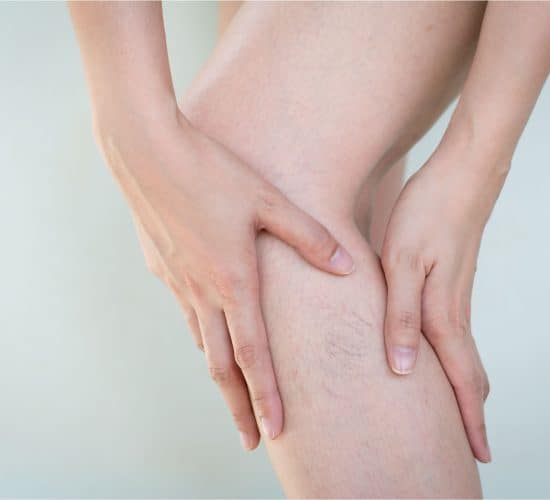
OVERVIEW
Varicose veins are swollen and enlarged blood vessels that may cause pain and discomfort in those who have it. A milder version of this is spider veins. While these veins can be found anywhere on the body, they are often present in the legs due to increased pressure in the lower body from standing and walking upright.
These visible veins are caused by weakened valves which malfunction. As a result, there is a backflow of blood that pools in the veins instead of flowing to the heart and veins become congested, twisted, and lengthened.

SYMPTOMS
- Swollen and enlarged networks of red/purple/blue vessels,
- A heavy feeling or swelling in the legs, and
- Aching legs
- Skin discolouration or darkening around the veins
- Itchy skin around veins
CAUSES/RISK FACTORS
- Age. Varicose veins’ occurrence tends to increase with age, as the wear and tear of the vein valves will cause blood backflow and pooling.
- Gender. Varicose veins are more common among females as hormonal changes during pregnancy, pre-menstruation or menopause relax the vein walls.
- Pregnancy. During pregnancy, there will be an increase in the volume of blood in mother’s body, and veins enlarge the increased blood volume in order to support the fetus.
- Positive Family history. There is a higher tendency for patients to suffer from varicose veins if they have a strong family history of suffering from a similar condition.
- Obesity. Additional pressure are placed on veins when you are overweight.
- Standing for prolonged periods. Prolonged standing at work tend to result in poorer blood flow.
DIAGNOSIS
Varicose veins can be diagnosed through a thorough clinical physical examination from a professional as well as an ultrasound scan of the legs. The ultrasound scan is essential in determining the cause, degree, and extent of varicose veins.
OUR TREATMENTS
Conservative non-surgical treatment
- Includes the use of tight compression stockings. The stockings aid the flow of blood in the veins to alleviate symptoms and prevent the disease from progressing.
- Tight compression stockings can help to promote blood flow throughout the legs and may alleviate some discomfort, preventing the progression of the disease. However, more serious cases of varicose veins with prominent symptoms could require further treatment and care.
Traditional open surgery is known as high-tie and vein stripping – this method requires general anaesthesia and requires a night’s stay in hospital. Open surgery is often associated with greater pain and a slower process.
Minimally invasive procedures
- With the same benefits as traditional surgery, minimally invasive surgeries cause less pain and have a quicker recovery time as compared to traditional surgery. Instead of a large opening, the surgery is performed through a minuscule incision. Advancements in technology allow for only a small puncture for probes to be inserted into the vein to seal it off. This usually takes place as day surgery with a quick return to daily activities and no need for a disruption to your everyday life or an expensive hospital stay. It is done under local anaesthesia or light sedation where either heat, mechanical, or chemical means will be used to seal the vein.
Our treatment techniques include:
- Radio Frequency Ablation (RFA)
Radiofrequency energy is used to heat up and damage the vein wall. A fast and safe outpatient procedure, it takes about 35-40 minutes to perform. Furthermore, it is also a minimally invasive procedure. - Venseal™/VenaBlock Glue Closure
A small amount of specially formulated medical adhesive is used to seal the varicose vein permanently. Through the closure of these veins, blood is rerouted to healthy veins located nearby, providing relief. This procedure provides a comfortable experience and typically is completed within 15-20 minutes. - Clarivein™ Mechanochemical Ablation
This procedure combines the mechanical destruction of the veins and the injection of sclerosant (a chemical used in sclerotherapy that seals off veins). A special catheter is inserted that has a wire rotating at high speed, damaging the innermost layer of the vein (or the venous intima). At the same time, there is the controlled injection of sclerosant which seals off the vein. This is a painless technique which requires a lot less local anaesthetic injections. Additionally, there is no risk of heat-induced to surrounding nerves due to the mechanochemical ablation technique. - Cryo-Laser and Cryo-Sclerotherapy (CLaCs)
Suitable for spider veins, this procedure combines transdermal laser and injection sclerotherapy using a chemical sclerosant, all under skin cool (-20C). It leaves minimal scarring and pigmentation post-surgery. This procedure makes use of the Harmony XL PRO, a powerful treatment tool for your aesthetic needs. Using its light, laser, and AFT (Advanced Fluorescence Technology), affected blood vessels beneath the skin are targeted. The treatments are safe and effective, providing you with the long term, reliable results that you desire.
Varicose Vein Treatment Singapore
These minimally invasive procedures will aid in curing stubborn varicose veins and minimising their appearance, helping you to achieve skin that is not only smooth and clear but most importantly, pain-free.
Click here to download our Spider and Varicose Vein brochure

